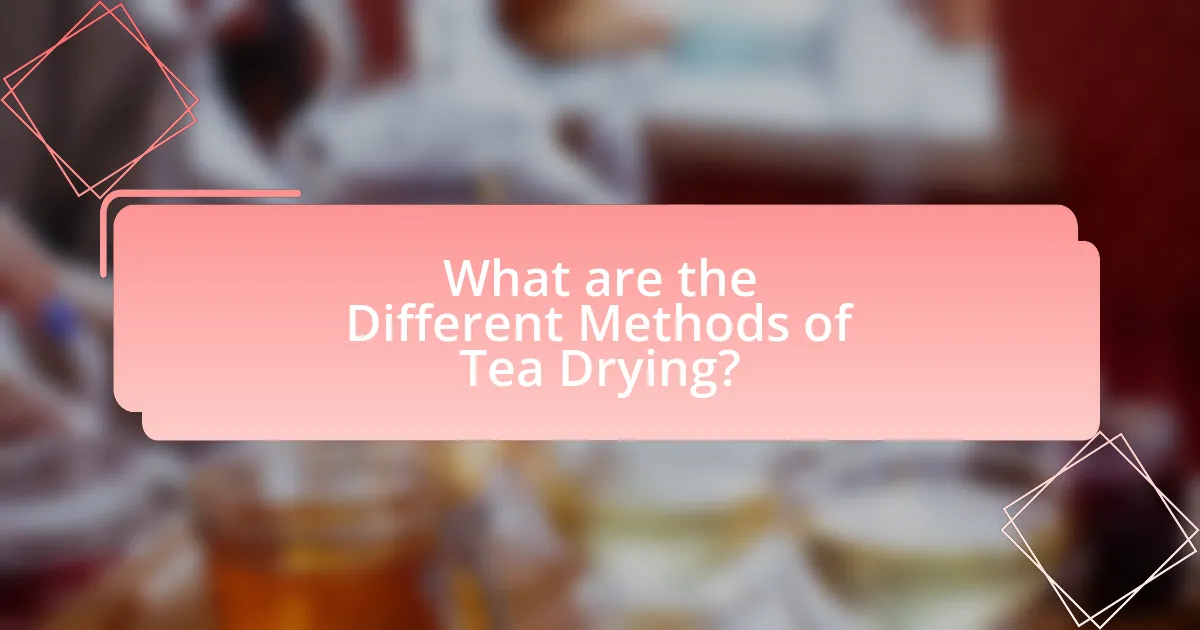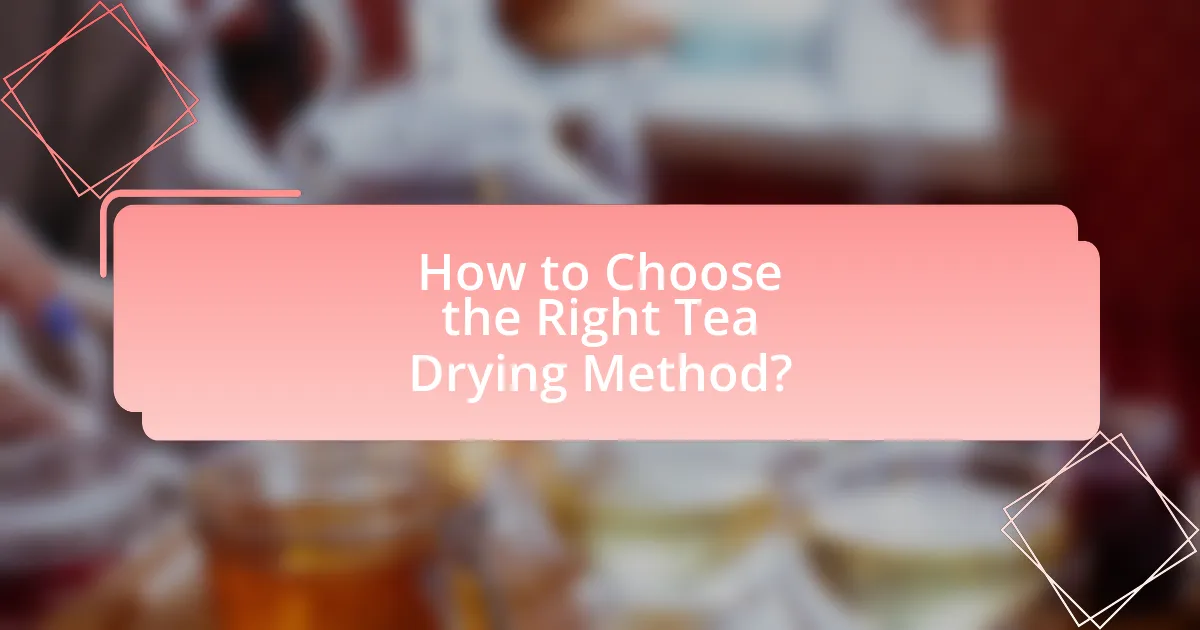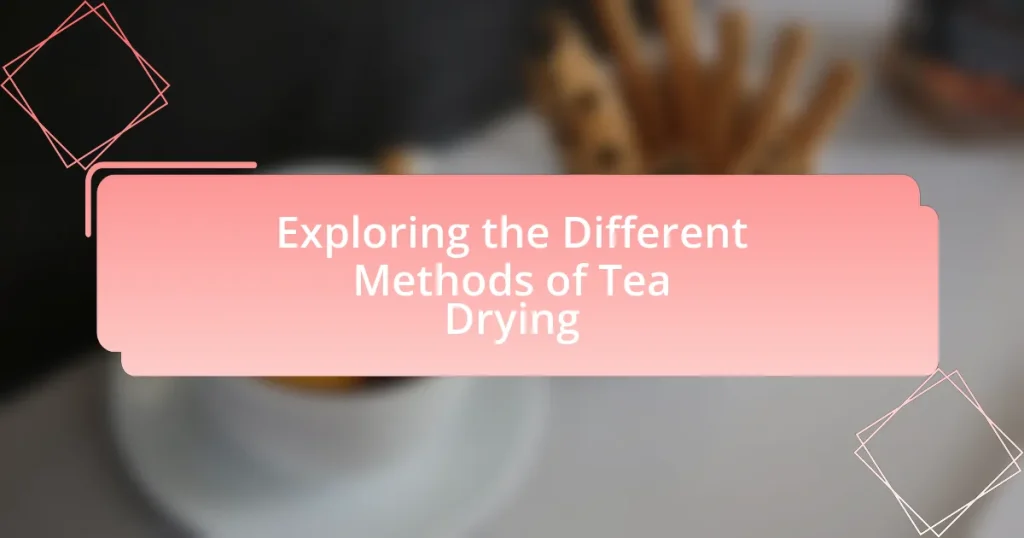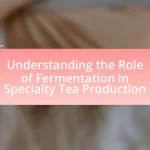The article explores various methods of tea drying, including sun drying, air drying, pan firing, and oven drying, each impacting the flavor and quality of tea differently. It contrasts traditional techniques, which rely on natural processes, with modern methods that utilize controlled environments for efficiency and consistency. Key characteristics of each drying method are examined, along with their influence on tea preservation, flavor retention, and shelf life. Additionally, the article discusses factors affecting the choice of drying methods, such as tea type, climate conditions, and production scale, while highlighting best practices for effective tea drying.

What are the Different Methods of Tea Drying?
The different methods of tea drying include sun drying, air drying, pan firing, and oven drying. Sun drying involves spreading tea leaves in sunlight, allowing natural heat to evaporate moisture, which is a traditional method used in many regions. Air drying utilizes warm air circulation to remove moisture, often in controlled environments to maintain quality. Pan firing, commonly used in Chinese tea production, involves heating tea leaves in a pan to halt oxidation and reduce moisture content. Oven drying employs controlled heat in an oven to achieve similar results, providing a consistent drying process. Each method affects the flavor and quality of the tea, with specific techniques preferred based on the type of tea being produced.
How do traditional methods of tea drying differ from modern techniques?
Traditional methods of tea drying primarily involve natural processes such as sun drying or pan firing, while modern techniques often utilize controlled environments like electric dryers or hot air systems. Traditional sun drying relies on sunlight and air circulation, which can take several days and may result in variability in moisture content. In contrast, modern techniques allow for precise temperature and humidity control, significantly reducing drying time to a few hours and ensuring uniform moisture levels. This shift enhances efficiency and consistency in tea production, as evidenced by the widespread adoption of mechanical drying methods in commercial tea processing.
What are the key characteristics of traditional tea drying methods?
Traditional tea drying methods are characterized by their reliance on natural processes and minimal technological intervention. These methods often include sun drying, where freshly harvested tea leaves are spread out in the sun to evaporate moisture, and pan firing, which involves heating the leaves in a pan to halt oxidation and reduce moisture content. Historical practices, such as those used in China and Japan, emphasize the importance of maintaining the tea’s flavor and aroma through careful temperature control and timing. For instance, sun drying can take several hours to days, depending on climate conditions, while pan firing typically occurs at temperatures around 200°C for a few minutes. These methods not only preserve the essential qualities of the tea but also reflect cultural traditions and regional variations in tea production.
How have modern technologies influenced tea drying processes?
Modern technologies have significantly enhanced tea drying processes by introducing methods such as hot air drying, infrared drying, and microwave drying. These advanced techniques improve efficiency and consistency in moisture removal, leading to better flavor retention and reduced processing time. For instance, hot air drying allows for precise temperature control, which minimizes the risk of over-drying and preserves essential oils in the tea leaves. Infrared drying, on the other hand, accelerates the drying process by directly heating the leaves, resulting in a more uniform product. Additionally, microwave drying can reduce drying time to mere minutes while maintaining the quality of the tea. These innovations reflect a shift towards more efficient, controlled, and quality-focused tea production methods.
Why is the drying process crucial in tea production?
The drying process is crucial in tea production because it halts enzymatic activity, preserving the flavor and aroma of the tea leaves. By removing moisture, drying prevents spoilage and microbial growth, ensuring the tea remains safe for consumption. Studies indicate that proper drying techniques can enhance the retention of essential oils and antioxidants, which are vital for the tea’s quality and health benefits. For instance, research published in the Journal of Food Science highlights that optimal drying conditions can significantly improve the sensory attributes of tea, confirming the importance of this step in the production process.
What role does drying play in preserving tea flavor and aroma?
Drying plays a crucial role in preserving tea flavor and aroma by reducing moisture content, which prevents the growth of mold and bacteria. This process helps to lock in the volatile compounds responsible for the tea’s unique taste and scent. For instance, studies show that proper drying techniques can maintain the integrity of essential oils and polyphenols, which are key to flavor and aroma. By eliminating excess moisture, drying ensures that the tea retains its quality during storage and extends its shelf life, ultimately enhancing the consumer’s experience.
How does drying affect the shelf life of tea?
Drying significantly extends the shelf life of tea by reducing moisture content, which inhibits the growth of mold and bacteria. When tea leaves are dried, typically to a moisture level below 5%, they become less susceptible to spoilage and degradation. Research indicates that properly dried tea can maintain its quality for several months to years, depending on storage conditions. For instance, studies show that green tea, when dried and stored in airtight containers away from light and heat, can last up to two years without significant loss of flavor or aroma.
What factors influence the choice of tea drying method?
The choice of tea drying method is influenced by factors such as the type of tea being produced, desired flavor profile, moisture content, and available technology. Different tea varieties, like green, black, or oolong, require specific drying techniques to preserve their unique characteristics; for instance, green tea typically undergoes steaming or pan-firing to halt oxidation, while black tea is often dried using hot air to enhance its flavor. Additionally, the moisture content of freshly processed tea leaves dictates the drying method, as higher moisture levels may necessitate more intensive drying processes. Technological advancements also play a role, as modern equipment can offer more efficient and controlled drying options, impacting the final quality of the tea.
How do climate and environmental conditions impact drying techniques?
Climate and environmental conditions significantly influence drying techniques by affecting the rate of moisture removal from tea leaves. High humidity levels can slow down the drying process, necessitating the use of more energy-intensive methods such as mechanical drying, while arid conditions facilitate faster drying through natural evaporation. For instance, in regions with low humidity, sun drying can be effective, as the dry air enhances moisture loss. Conversely, in humid climates, techniques like hot air drying or dehumidification are often employed to achieve optimal results. Studies have shown that the efficiency of drying methods can vary by up to 50% depending on local climate conditions, highlighting the critical role of environmental factors in determining the most suitable drying technique for tea.
What types of tea are best suited for specific drying methods?
Green tea is best suited for pan-firing or steaming drying methods, as these techniques preserve its fresh, grassy flavor and vibrant green color. Oolong tea benefits from a process called withering followed by roasting, which enhances its complex flavors and aromatic qualities. Black tea is ideally suited for a method known as oxidation followed by drying, which develops its rich, robust taste and dark color. White tea, on the other hand, is best dried using a gentle air-drying method to maintain its delicate flavor profile and subtle sweetness. Each type of tea requires specific drying methods to optimize its unique characteristics and flavor profiles.

What are the Common Techniques Used in Tea Drying?
Common techniques used in tea drying include sun drying, pan firing, and oven drying. Sun drying involves spreading tea leaves in sunlight, allowing natural heat to evaporate moisture, which is often used in regions with ample sunlight. Pan firing, a method prevalent in Chinese tea production, involves heating leaves in a hot pan to halt oxidation and reduce moisture content. Oven drying utilizes controlled heat in an oven to achieve consistent drying, ensuring uniform moisture removal. Each technique impacts the flavor and quality of the tea, with sun drying often imparting a unique character due to the influence of environmental conditions.
What is sun drying and how is it performed?
Sun drying is a method of drying tea leaves using direct sunlight to remove moisture. This process involves spreading freshly harvested tea leaves on flat surfaces, such as trays or mats, in a sunny location. The leaves are typically turned periodically to ensure even drying and to prevent fermentation. Sun drying is effective in reducing the moisture content of the leaves to around 10-12%, which is essential for preserving flavor and preventing spoilage. This traditional technique is widely used in regions with ample sunlight and low humidity, making it a cost-effective and natural method for tea processing.
What are the advantages and disadvantages of sun drying tea?
Sun drying tea offers several advantages and disadvantages. The primary advantage is that it is a cost-effective method, requiring no specialized equipment and utilizing natural sunlight, which can enhance the flavor profile of the tea by preserving essential oils and aromas. Additionally, sun drying can be environmentally friendly, as it reduces energy consumption compared to mechanical drying methods.
Conversely, the main disadvantage of sun drying tea is its susceptibility to weather conditions, which can lead to inconsistent drying results and potential contamination from dust, insects, or pollutants. Furthermore, the process can take longer than other drying methods, increasing the risk of spoilage if not monitored properly.
How does sun drying affect the flavor profile of tea?
Sun drying enhances the flavor profile of tea by concentrating its natural sugars and essential oils, resulting in a sweeter and more aromatic brew. This method allows the tea leaves to develop complex flavors due to the slow evaporation of moisture, which can intensify the inherent characteristics of the tea variety. Research indicates that sun-dried teas often exhibit a more pronounced floral or fruity note, as the sunlight catalyzes chemical reactions within the leaves that contribute to flavor development. For instance, studies have shown that traditional sun-dried teas from regions like Darjeeling and Assam possess unique flavor profiles that are distinct from those dried using mechanical methods, highlighting the impact of this natural drying process on taste.
What is oven drying and what are its key features?
Oven drying is a method of removing moisture from tea leaves by using a controlled heat source, typically an electric oven. This technique involves placing the tea leaves in an oven at a specific temperature, usually between 60 to 80 degrees Celsius, for a set duration to ensure even drying without compromising the flavor or quality of the tea. Key features of oven drying include precise temperature control, uniform heat distribution, and the ability to quickly reduce moisture content, which helps in preserving the essential oils and flavors of the tea. Additionally, this method is efficient and can be easily monitored, making it a popular choice for small-scale tea producers.
How does temperature control in oven drying impact tea quality?
Temperature control in oven drying significantly impacts tea quality by influencing the chemical composition and flavor profile of the tea leaves. Proper temperature regulation ensures that essential oils and aromatic compounds are preserved, which are crucial for the tea’s flavor and aroma. For instance, drying tea at temperatures above 80°C can lead to the degradation of these compounds, resulting in a flat taste and loss of aroma. Conversely, maintaining lower temperatures, typically between 60°C to 70°C, allows for optimal drying while retaining the desirable characteristics of the tea. Studies have shown that precise temperature control during the drying process can enhance the overall sensory attributes of the tea, making it more appealing to consumers.
What types of tea benefit most from oven drying?
Oven drying benefits primarily green and herbal teas. Green teas, such as Sencha and Matcha, require careful drying to preserve their fresh flavor and vibrant color, making oven drying an effective method. Herbal teas, like chamomile and peppermint, also benefit from oven drying as it helps to retain essential oils and flavors while reducing moisture content efficiently. This method allows for consistent heat application, which is crucial for maintaining the quality of these teas during the drying process.
What is air drying and how does it work?
Air drying is a method of removing moisture from tea leaves by exposing them to ambient air. This process works through the natural evaporation of water content in the leaves, facilitated by air circulation and temperature. As the moisture evaporates, the leaves undergo chemical changes that enhance flavor and aroma, making air drying a preferred technique in traditional tea processing. Studies indicate that air drying can preserve essential oils and compounds, contributing to the overall quality of the tea.
What are the benefits of using air drying for tea?
Air drying for tea offers several benefits, including preservation of flavor and aroma, retention of essential oils, and a more natural drying process. This method allows tea leaves to dry slowly in ambient air, which helps maintain their delicate compounds and prevents the loss of volatile aromas that can occur with higher heat methods. Additionally, air drying is energy-efficient and environmentally friendly, as it requires no electricity or specialized equipment, making it a sustainable choice for tea producers. Studies have shown that air-dried tea can have enhanced flavor profiles compared to those dried using artificial methods, as the gradual drying process allows for better development of the tea’s natural characteristics.
How does air drying compare to other drying methods in terms of efficiency?
Air drying is generally less efficient than other drying methods such as oven drying or freeze drying, primarily due to its reliance on ambient conditions and longer drying times. While air drying can preserve flavor and aroma in tea, it typically takes several hours to days, depending on humidity and airflow, compared to oven drying, which can complete the process in a matter of hours. Studies indicate that oven drying can reduce moisture content to desired levels more quickly, often achieving efficiency rates of over 90% in less than two hours, while air drying may only reach similar moisture levels after extended periods.

How to Choose the Right Tea Drying Method?
To choose the right tea drying method, consider the type of tea being produced, as different teas require specific drying techniques to preserve flavor and aroma. For example, green tea typically uses pan-firing or steaming to halt oxidation, while black tea often employs withering followed by hot air drying to enhance its robust flavor. The choice of method also depends on the desired moisture content; optimal moisture levels for storage and flavor retention vary by tea type. Additionally, factors such as equipment availability, energy efficiency, and cost-effectiveness should be evaluated to ensure the selected method aligns with production goals.
What considerations should be made when selecting a drying method?
When selecting a drying method for tea, key considerations include the type of tea, desired flavor profile, moisture content, and energy efficiency. The type of tea influences the optimal drying temperature and duration; for instance, green tea requires lower temperatures to preserve its fresh flavor, while black tea can withstand higher temperatures. The desired flavor profile also dictates the drying method, as different techniques can enhance or diminish specific taste characteristics. Moisture content is critical, as insufficient drying can lead to spoilage, while excessive drying can result in loss of essential oils and flavor. Energy efficiency is important for cost-effectiveness and sustainability, with methods like solar drying being more eco-friendly compared to electric or gas-powered options.
How do production scale and resources affect method choice?
Production scale and resources significantly influence the choice of tea drying methods. Larger production scales typically necessitate more efficient, high-capacity drying techniques, such as industrial hot air dryers or rotary dryers, to meet demand and maintain consistency. In contrast, smaller-scale operations may opt for traditional methods like sun drying or pan firing, which require fewer resources and lower initial investments. For instance, a study by the Food and Agriculture Organization highlights that smallholder tea producers often rely on manual drying methods due to limited access to capital and technology, while larger producers invest in mechanized systems to enhance productivity and reduce drying time. Thus, the scale of production and available resources directly dictate the feasibility and efficiency of various drying methods in tea processing.
What are the implications of method choice on tea quality?
The choice of drying method significantly impacts tea quality by influencing flavor, aroma, and chemical composition. For instance, traditional sun drying can enhance the natural flavors of the tea leaves, while mechanical drying may lead to a more uniform product but can also diminish some of the nuanced flavors. Research indicates that different drying techniques, such as hot air drying or pan firing, can alter the levels of catechins and other antioxidants, which are crucial for health benefits and taste. A study published in the Journal of Food Science by authors Zhang et al. (2020) demonstrated that teas dried using lower temperatures retained higher antioxidant levels compared to those dried at higher temperatures, thus affecting overall quality.
What are the best practices for effective tea drying?
The best practices for effective tea drying include controlling temperature, ensuring proper airflow, and monitoring humidity levels. Maintaining a temperature between 50°C to 70°C optimizes moisture removal without damaging the tea’s flavor and aroma. Adequate airflow prevents moisture accumulation, which can lead to mold growth, while humidity levels should ideally be kept below 60% to ensure efficient drying. These practices are supported by research indicating that precise temperature and humidity control significantly enhance the quality and shelf life of dried tea.
How can one ensure optimal drying conditions for different tea types?
To ensure optimal drying conditions for different tea types, one must control temperature, humidity, and airflow specific to each tea variety. For instance, green tea requires lower temperatures (around 60-70°C) and higher humidity to preserve its delicate flavors, while black tea benefits from higher temperatures (around 80-90°C) and lower humidity to enhance oxidation. Additionally, airflow must be adjusted; for oolong tea, a moderate airflow helps achieve the desired balance between moisture removal and flavor retention. These conditions are supported by research indicating that precise control of these factors directly influences the quality and flavor profile of the final tea product.
What common mistakes should be avoided during the tea drying process?
Common mistakes to avoid during the tea drying process include excessive heat application, inadequate airflow, and insufficient monitoring of moisture levels. Excessive heat can lead to the loss of essential oils and flavors, negatively impacting the tea’s quality. Inadequate airflow can cause uneven drying, resulting in mold growth and spoilage. Insufficient monitoring of moisture levels may lead to under-drying or over-drying, both of which can compromise the tea’s taste and shelf life. These mistakes can significantly affect the final product, making it crucial to adhere to proper drying techniques and conditions.


